The Economics and Statistics Division maintains archives of previous publications for accountability purposes, but makes no updates to keep these documents current with the latest data revisions from Statistics Canada. As a result, information in older documents may not be accurate. Please exercise caution when referring to older documents. For the latest information and historical data, please contact the individual listed to the right.
<--- Return to Archive
For additional information relating to this article, please contact:
October 20, 2021ANALYSIS OF NOVA SCOTIA'S CONSUMER PRICE INDEX FOR SEPTEMBER 2021 TRENDS – SEPTEMBER 2021
Nova Scotia’s All-Items Consumer Price Index (CPI) increased 5.2 year-over-year in September 2021, ticking upwards from the 5.1% year-over-year increase in August. Nationally, consumer prices were up 4.4% from a year earlier, following a 4.1% increase in August 2021.
The increase at the national level was the fastest pace since February 2003. Statistics Canada noted that the national prices increase were attributable to higher gasoline prices (+32.8% compared to September 2020) as there is reduced output by major oil-producing countries compared to pre-pandemic levels. Excluding gasoline prices, the CPI was 3.5% higher than last year.
Food prices accelerated to a 3.9% year-over-year in September, led by higher meat prices (+9.5%) with higher input costs, temporary closures, supply chain disruptions, and strengthening demand. Prices for fats, edible oils, butter, cheese and eggs were all higher than last year while fresh vegetables (-3.2%) were driven lower by tomato prices.
The homeowner's replacement cost index, related to price of new homes, rose at it's fastest pace (+14.4%) in more than 30 years. Price growth has trended upward in the past year with higher construction costs and low interest rates. Passenger vehicles prices rose 7.2% as supply was limited amid global semiconductor chip shortage.
Impact of COVID-19 on the Consumer Price Index
Statistics Canada continued special CPI program measures for September 2021.As products become available for consumption again they are re-introduced into CPI calculation with an adjustment factor so that only that index's price movement impacts the calculation. (March 2021 Technical supplemental). Caution should be exercised with the 12-month change in the travel tour and air transportation indexes. Cruise-based travel tours, accounting for 0.03%, are the only item with special treatment in September 2021 .
Inflation was led by Prince Edward Island (+6.3%) and Saskatchewan had the slowest growth (+3.3%).Compared to the previous month, all provinces except Newfoundland and Labrador, Prince Edward Island, and Alberta had increases in the CPI index in September 2021.
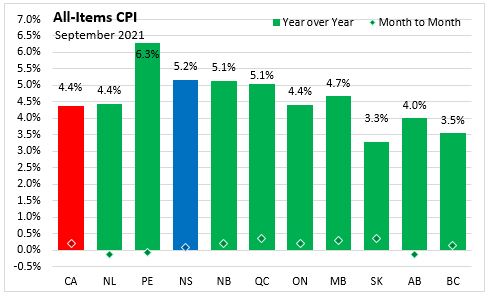
Nova Scotia’s consumer price inflation (year-over-year) excluding food and energy increased 3.2% in September 2021. Consumer prices excluding food and energy were up in all provinces led by Quebec (+4.1%). Newfoundland and Labrador had the smallest increase at 1.8%.
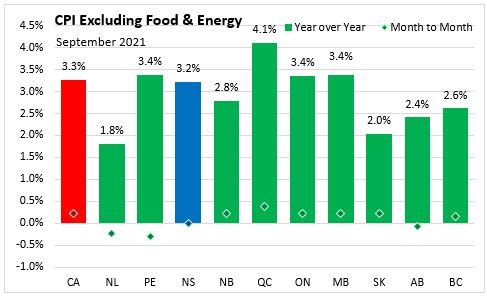
The CPI for food in Nova Scotia increased 4.4% year-over-year in September 2021, a 1.5 percentage point increase compared to the 2.9% year-over-year increase in August. Nationally, food prices were up 3.9% from a year earlier. All provinces recorded year-over-year increase in food prices led by New Brunswick (+5.9%). Manitoba had the lowest increase at 3.3%.
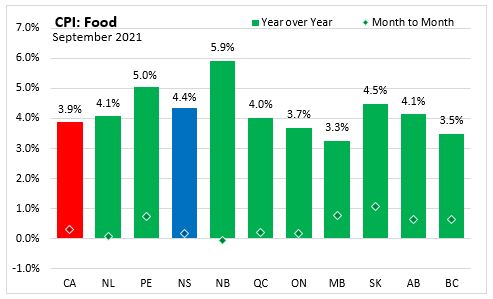
Nova Scotia energy prices increased 24.9% year-over-year in September 2021 compared to the national average of 20.1%. All provinces reported double digit increases in energy prices. The year-over-year change in Nova Scotia’s and other Atlantic provinces' energy CPI is more exposed to the effects of changes in oil prices on inflation due to a larger use of fuel as a source of home heating compared to other provinces.

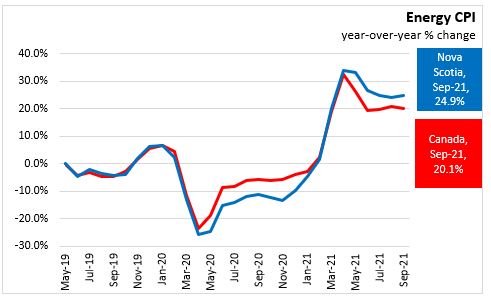
Year-over-year, shelter costs in Nova Scotia increased 6.0% in September 2021, above the national average increase of 4.8%. Compared to September 2020, shelter prices were up in all provinces with the largest increase in Prince Edward Island (+10.7%) and the smallest increase in Saskatchewan (+0.9%).
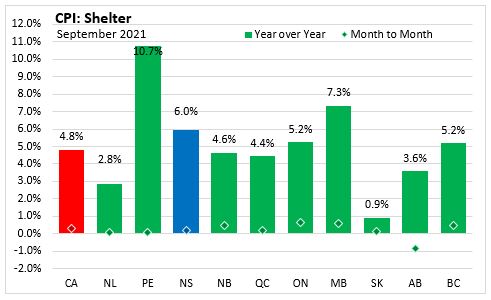
Nova Scotia's consumer price inflation (year-over-year growth in CPI) excluding energy was 3.4% in September compared to a national rate of 3.3%. Quebec (+4.1%) posted the largest year-over-year gain while the CPI excluding energy had the smallest change in Newfoundland and Labrador (+2.3%).
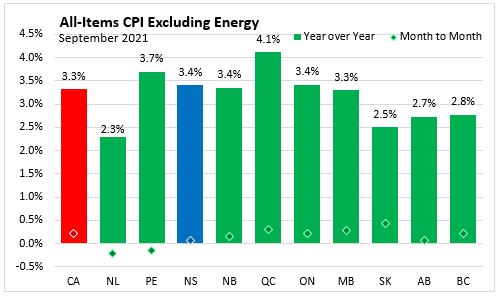
Major Components for September 2021
The following table shows the price increases specific to Nova Scotia for the major components of the CPI this month:
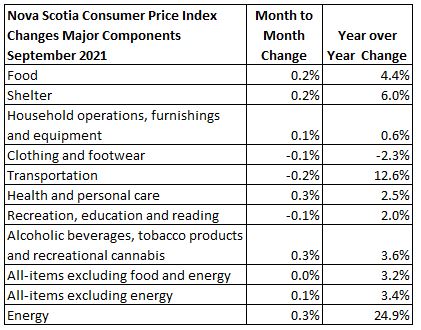
The main contributors to the monthly change (September 2021 vs August 2021) in Nova Scotia CPI were:
- Rent (+1.3%)
- Traveller accommodation (+9.1%)
- Tuition fees (3.7%)
- Video and audio subscription services (-12.5%)
- Inter-city transportation (-13.1%)
- Men's clothing (-3.5%)
The main contributors to the yearly change (September 2021 vs September 2020) in Nova Scotia CPI were:
- Gasoline (+43.0%)
- Purchase and leasing of passenger vehicles (+7.3%)
- Fuel oil and other fuels (+34.0%)
- Telephone services (-13.2%)
- Mortgage interest cost (negative contribution, percent change not available)
- Women's clothing (-5.9%)
Long Run Trends
In September 2021, the All-Items CPI year-over-year inflation rate for Nova Scotia was 5.2%, above Canada's rate at 4.4%. Month-to-month movements in the indices can be different, but over time they generally follow the same overall trend. Nova Scotia’s all-items CPI increase of 5.2% in September 2021 was the largest increase since March 2003 (+6.9%).

Nova Scotia’s CPI excluding food and energy increase of 3.2%, decreasing 0.3 percentage point from the 3.5% increase the previous month. Canada CPI excluding food and energy rose 0.3 percentage points from 3.0% to 3.3%.The NS CPI excluding food and energy was previously above 3 per cent in 2003.
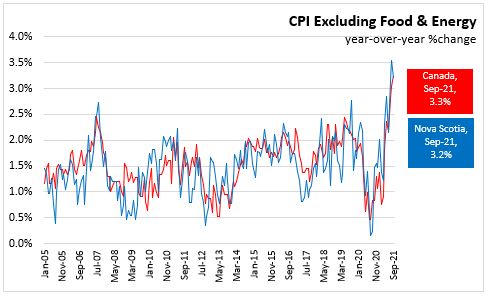
Bank of Canada's preferred measures of core inflation
Compared to September 2020, CPI-Common increased 1.8%, CPI-Median increased 2.8% and CPI-Trim was up 3.4% in Canada. All-items CPI excluding eight of the most volatile components as defined by the Bank of Canada and excluding the effect of changes in indirect taxes (formerly referred to as CPIX), rose 3.7% year-over-year. The change in the core inflation measures were unchanged for CPI-common, up 0.2 percentage point for both CPI-median and CPI-trim.
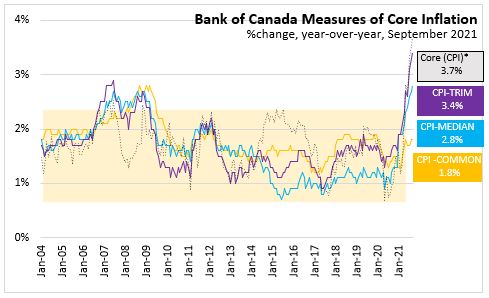
Appendix Tables and Charts
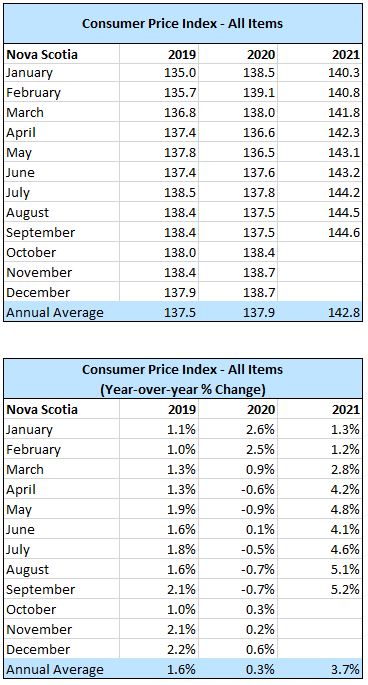
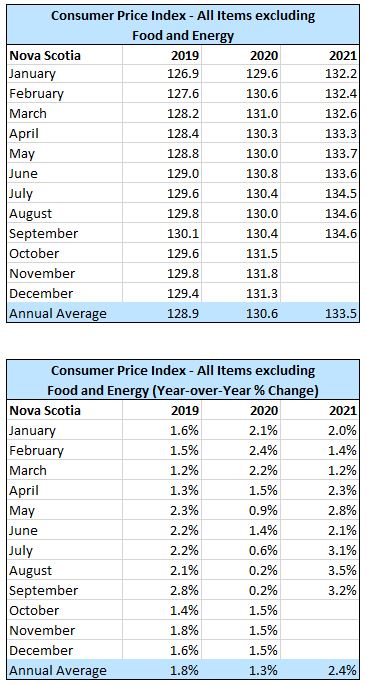
Basket Update
With the June 2020 release the CPI basket of goods and services has been updated. The new basket weights are based on 2020 expenditure data, in which spending would reflect pre-pandemic patterns (Jan-Feb), an economy mostly in lockdown (March-June), and the emergence of new consumption patterns as economy re-opened (July-December). Statistics Canada notes that the "The data reflect shifts in spending due to the COVID-19 pandemic that will likely take some time to stabilize across goods and services, and geographic regions" and the June 2021 headline CPI for Canada would be the same if the previous basket weights (2017) were used. The weights for shelter (+2.86 percentage points), households operations, furnishings and equipment (+2.23 percentage points), and alcoholic beverages, tobacco products and recreational cannabis (+1.7 percentage points) are higher in the 2020 basket while transportation had the largest decline falling from a 19.72% share to 15.34% share. New products classes were added for shipping fees and local delivery fees (including restaurant and grocery delivery fees), digital subscriptions services to magazines, and video game consoles. Further information on the update can be found in An Analysis of the 2021 Consumer Price Index Basket Update, Based on 2020 Expenditures
Source: Statistics Canada. Table 18-10-0004-01 Consumer Price Index, monthly, not seasonally adjusted; Table 18-10-0256-01 Consumer Price Index (CPI) statistics, measures of core inflation and other related statistics - Bank of Canada definitions
<--- Return to Archive